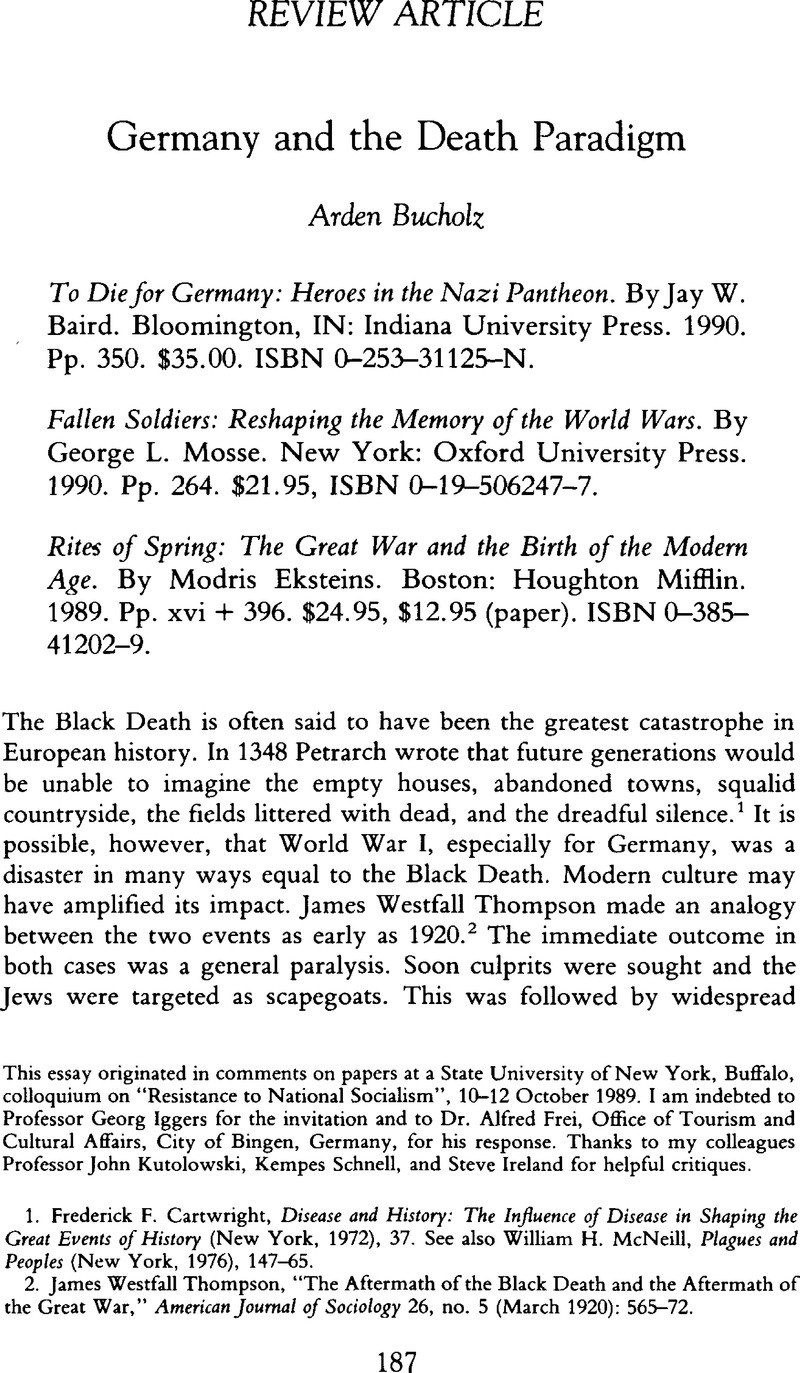No CrossRef data available.
Published online by Cambridge University Press: 16 December 2008

This essay originated in comments on papers at a State University of New York, Buffalo, colloquium on “Resistance to National Socialism”, 10–12 October 1989. I am indebted to Professor Georg Iggers for the invitation and to Dr. Alfred Frei, Office of Tourism and Cultural Affairs, City of Bingen, Germany, for his response. Thanks to my colleagues Professor John Kutolowski, Kempes Schnell, and Steve Ireland for helpful critiques.
1. Cartwright, Frederick F., Disease and History: The Influence of Disease in Shaping the Great Events of History (New York, 1972), 37.Google Scholar See also McNeill, William H., Plagues and Peoples (New York, 1976), 147–65.Google Scholar
2. Thompson, James Westfall, “The Aftermath of the Black Death and the Aftermath of the Great War,” American Journal of Sociology 26, no. 5 (03 1920): 565–72.CrossRefGoogle Scholar
3. Tuchman, Barbara, A Distant Mirror: The Calamitous 14th Century (New York, 1978), xiii.Google Scholar
4. Toynbee, Arnold, “The Relation between Life and Death, Living and Dying” in Schneidman, Edwin S., ed., Death: Current Perspectives (Palo Alto, 1976), 322–32.Google Scholar
5. Mosse, George L., Fallen Soldiers (New York: 1990), 116, 124.Google Scholar
6. Ibid., 162.
7. Eksteins, Modris, Rites of Spring (Boston, 1989), xiii.Google Scholar
8. Riley, John W. Jr., “Death and Bereavement” in International Encyclopedia of the Social Sciences, vol. 4 (New York, 1968), 19–20.Google Scholar See also Aries, Philippe, Western Attitudes toward Death (London, 1974)Google Scholar, and Ladurie, Emmanuel LaRoy, “Chaunu Lebrun, Vovelle: The New History of Death,” in Ladurie, Emmanuel LeRoy, The Territory of the Historian (Chicago, 1979).Google Scholar
9. Marris, Peter, Loss and Change (New York, 1974), 6, 10.Google Scholar
10. Ibid., 32–34. In considering the relationship between past and future, or as Reinhart Kosseleck describes it, between experience and expectations, one is reminded of Heinrich Heine's statement: “As for the Germans, they need neither freedom nor equality. They are a speculative people, ideologues, before-and-after thinkers, dreamers who live only in the past and the future and have no present.” Quoted in Christopher Lehmann-Haupt's review of Amity Schlaes's book Germany: The Empire Within, New York Times, 14 February 1991, section C, p. 27. See also Kosseleck, Reinhart, Futures Past: On the Semantics of Historical Time (Cambridge, MA, 1983), xxiii–xxiv.Google Scholar
11. Lifton, Robert Jay, The Broken Connection: On Death and Continuity of Life (New York, 1979) 176–78.Google Scholar Elisabeth Kuebler-Ross identified five stages of grief in terminal patients: shock, denial, anger, bargaining, depression, and acceptance. Ross, Elisabeth Kuebler, On Death and Dying (New York, 1969).Google Scholar
12. Reinhart Kosellectk's way of describing past and future. Koselleck, Futures Past.
13. Scholder, Klaus, The Churches and the Third Reich, 2 vols. (Philadelphia, 1988), 2:1.Google Scholar For the post-World War I world, Peter Loewenberg deals with age cohorts and youth, but does not touch upon them as mourners. See Loewenberg, Peter, “The Psychohistorical Origins of the Nazi Youth Cohort,” in Loewenberg, Peter, Decoding the Past: The Psychohistorical Approach (New York, 1983), 240–83;Google Scholar for post-World War II Germany this situation has been examined by Alexander, and Mitscherlich, Margarete in The Inability to Mourn: Principles of Collective Behavior (New York, 1973)Google Scholar; however, their definition of the problem does not include the analytical consideration of mourning and survivors found in recent literature on death and dying.